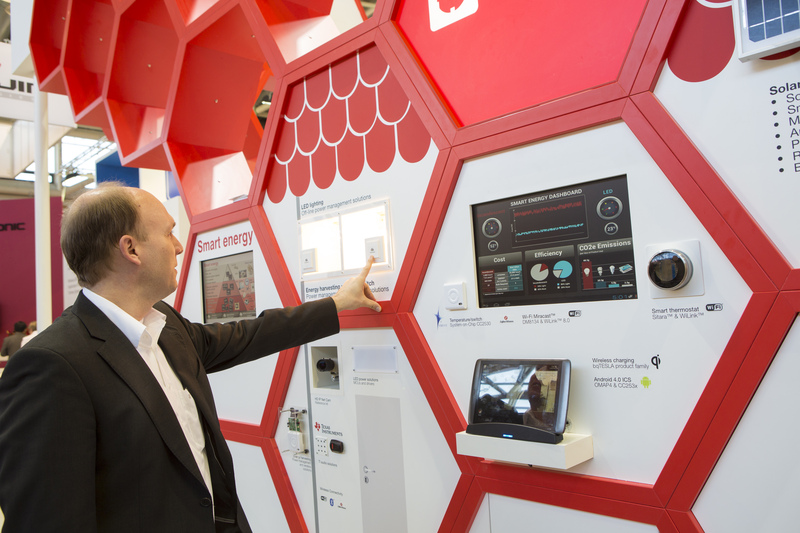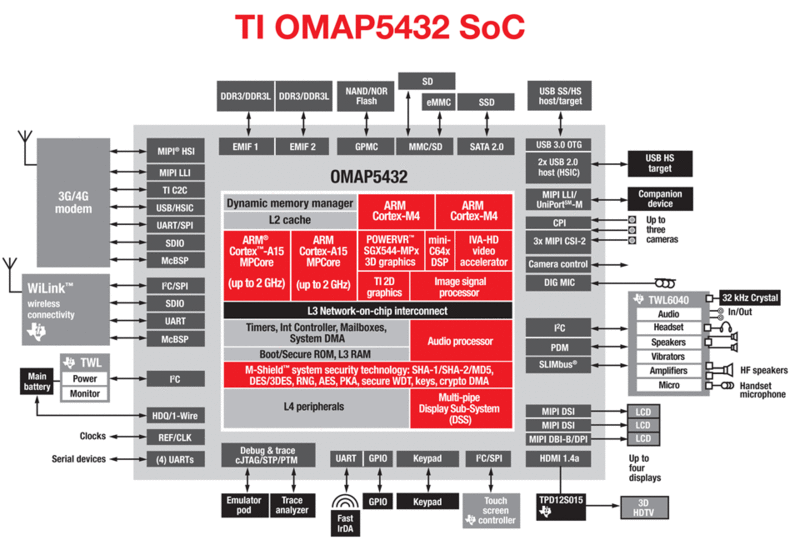Fifth Generation TI OMAP5 Processor from Texas Instruments
 Last week in Munich, the international exhibition Electronica 2012 was held - one of the most ambitious annual events in the world of microelectronics. Of course, Texas Instruments, a well-known company, could not pass by such an event. Her exposition at the exhibition was held under the slogan "Hexagon by Hexagon" (I find it difficult to translate into great and mighty), which found a response in the design of stands.
Last week in Munich, the international exhibition Electronica 2012 was held - one of the most ambitious annual events in the world of microelectronics. Of course, Texas Instruments, a well-known company, could not pass by such an event. Her exposition at the exhibition was held under the slogan "Hexagon by Hexagon" (I find it difficult to translate into great and mighty), which found a response in the design of stands.
TI Overview
The main specialization of the company TI (Texas Instruments) is the production of microcircuits on semiconductor technology. This company has a long, 80-year history (it appeared back in 1930), that is, it was formed much earlier than they invented the first integrated circuit.
Almost 96% of the entire product line of the company consists of semiconductor chips, among them are devices for military electronics. TI semiconductors are used in audio devices, telecommunications systems, communication devices, as well as consumer electronics, computers and peripherals for them.
')
The company is the fourth largest manufacturer of semiconductor systems in the world, second only to such flagships as Intel, Toshiba and Samsung.
Nowadays, products of this company are confidently chosen by electronics engineers, since they are truly ergonomic, high-performance and efficient solutions. TI chips implement many functions at the hardware level, by combining which OMAP technology has reduced the cost of mobile devices, ensuring, for example, the transmission of video images with a frequency of 30 frames / sec. At the same time, processors based on this technology are characterized by relatively low power consumption, and at the same time, a wide range of options available to them.
And this year Texas Instruments announced 2 new processors, already the fifth series - OMAP 5 .
The main directions of application of new OMAP processors from TI:
- in professional audio equipment: mixers, audio synthesizers, equipment for audio conferencing and broadcasting
- in portable devices and devices: audio, measuring and consumer purposes
- in medical technology (portable as well)
- in production automation: programmable controllers, test and measuring equipment
- in smartphones
- in tablets and e-books
The new family of OMAP processors of the fifth generation currently contains 2 chips: OMAP 5430 and OMAP 5432. The first one is positioned by the company for smartphones, and the second one is mobile computers. In fact, the differences between the two processors are not so significant and we can talk about them as one processor of the TI OMAP 5 family.
The processors each contain four main cores that are made using 28 nm technology.

Cortex-A15 is now the fastest of the ARM micro-architectures. Its performance at comparable frequencies is 1.5 times higher than the performance of a direct competitor - the Cortex-A9 processor from TSMC. For example, the A15 chip at frequencies up to 800 MHz will work at about the same speed as the A9 chip at 1.5 GHz.
Early next year, another manufacturer, Apple, is planning to release a processor that is close in manufacturability and competitive to the A6, also manufactured using the 28-nm process technology (as Apple itself claims).
Another closest competitor to the OMAP 5 processor is the Exynos 4 Quad processor, made using HKMG technology. It will be made on 32-nm process technology, which is slightly weaker than TI. This processor can contain 4 Cortex A9 cores operating at frequencies up to 1.4 GHz. The manufacturer claims that the 4-core Exynos 4 Quad processor will consume 20% less power than the dual-core 32-nm Exynos 4 processor.
In terms of power consumption, the new OMAP 5 processor outperforms its closest relatives.
Key technical benefits of the new OMAP 5 processors
- Cortex A15 processor cores - up to 2 GHz
- support for 4 cameras designed to record video with up to 1080p resolution, including in 3D
- OMAP 5 processors are three times more productive in terms of computation and five times more powerful in 3D games than the chips of the previous generation and their direct competitors
- relative power consumption in the new processor will be reduced by 60%, in comparison with current models
- The new Cortex-A15 chip is based on the latest 28 nm technology.
- performance of the top processor version, in comparison with the OMAP 4430, will increase fivefold at the level of graphics and three times at the level of the main processor
- The new processor supports playback and recording of 3D video at 1080p resolution.
In addition, the OMAP 5 processor provides support for HDMI, RAM up to 8 GB based on dual-channel DDR3 / DDR3L sockets. The power consumption of the processor will not exceed the performance of current chips for mobile devices. For example, you can listen to up to 140 hours of audio quality CDs until the battery of the device containing the platform with the new processor is completely discharged. In general, the OMAP 5430 processors are designed for flagship tablets and smartphones, while the OMAP 5432 is designed for mid-range products.
In a new generation processor, tasks that do not require high performance will be handled by a pair of additional cores Cortex-M4 ARM - they are not so demanding of battery resources. All the hardware improvements presented above allow the processor to manage three displays simultaneously with a QSXGA resolution (2560 × 2048 pixels) on the new platform. It is possible to broadcast a video stream over an HDMI 1.4a type interface that has support for 3D technology.
As for the input data, the processor can easily cope with the four parallel cameras that have a total resolution of their sensors up to 24 megapixels. I will also note one more function that is supported at the level of hardware solutions: the possibility of combined data processing with a TI DLP picoprojector, which has a built-in camera.
This means that the pictures from the projector become interactive, a kind of touch display that appears on any surfaces where you direct the beam of the projector. In addition, the authors emphasize the support of this processor, three-dimensional interfaces such as Microsoft Kinect.
The new platform contains controllers SDXC, SATA 2.0, as well as OTG USB 3.0, there is support for hardware acceleration and coprocessors to implement functions such as the recognition of objects, faces, text.
The commercial launch of electronic devices based on TI OMAP 5 is expected early next year. The first products have already been presented at the TI booth at Electronica 2012 last week in Munich.
Source: https://habr.com/ru/post/159601/
All Articles